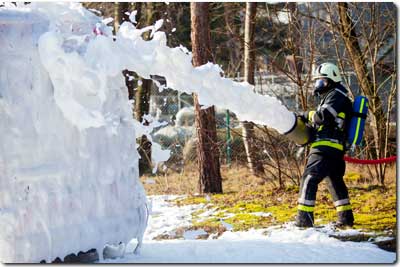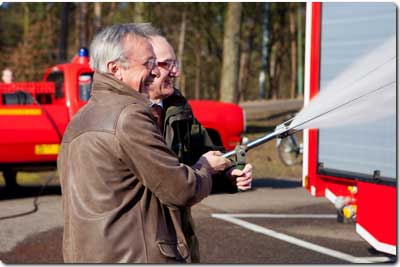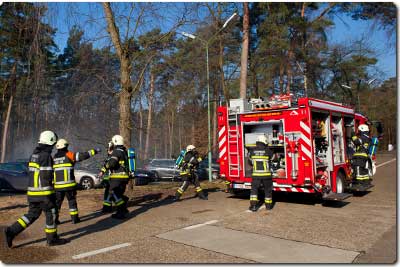
Brand new fire engine illustrates increased effectiveness of SCK•CEN’s fire brigade
In the presence of members of the Campine Fire Brigade Zone and of a number of company fire brigades, the fire brigade of the Belgian Nuclear Research Centre (SCK-CEN), in Mol, presented its latest fire engine. The fire engine was unveiled by SCK-CEN’s Director General Eric van Walle and by the Mayor of Mol, Paul Rotthier.
The new fire engine’s brand new medium-sized pump ladder has 2,500 litres of water and 300 litres of foam-forming liquid on board, and is fully equipped with fire fighting and life-saving equipment. The investment is consistent with the new approach of providing SCK•CEN’s fire brigade with all the latest equipment and knowledge needed to carry out an initial intervention, in anticipation of the arrival of the public fire brigade services. In the past, the role of the company fire brigade was restricted simply to providing guidance. To make this considerable transition possible, SCK•CEN, over a period of 3 years, has invested about €800,000 in equipment, infrastructure and training. The company fire brigade now comprises an expanded corps of 20 firemen and one woman, under the direction of a professional commander. The training of the volunteers is exactly the same as that for professional firemen.

Thanks to these major investments, the company fire brigade's operations are in line as much as possible with the methods and routines of the public fire brigade corps. Due to the nature of the activities on the SCK•CEN site, the company fire brigade specialises in chemical and nuclear risks and technical rescues at both great height and depth. And there is a very good reason for this - the research centre has an underground laboratory situated at a depth of 225 metres.

SCK-CEN is also surrounded by 335 hectares of forests. On the recommendation of the fire brigade of Mol, SCK•CEN has made major efforts to strengthen its fire fighting capacity in the forests. Additional roads and bridges were built to increase accessibility, and 6 water pits were drilled to guarantee the water supply. Recently, two special quays were also built to allow fire engines to quickly pump up large quantities of water from the Bocholt-Herentals canal. SCK•CEN will test the new infrastructure in the near future during exercises that will incorporate staff at both Mol and Geel.

This collaboration will also be strengthened in another way. Only recently, a joint action plan was developed for managing a number of specific scenarios, including a large kerosene fire. This was done is in answer to an important recommendation from the Belgian Federal Agency for Nuclear Control (FANC) within the context of the stress tests that SCK•CEN had to complete.
|

